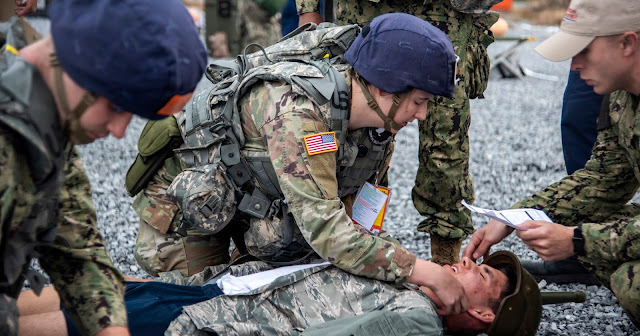By Ian Neligh
The recorded sounds of explosions and gunfire thunder from a large speaker as a military HMMWV ambulance pulls up. The back of the vehicle is full of first-year medical school students roleplaying as soldiers wounded in battle.
“I need a medic,” one cries out, climbing down and limping, his leg red with fake blood. The others have a host of grisly wounds created with extremely realistic makeup, representing a horrific line-up of injuries.
Students from the Uniformed Services University of the Health Sciences (USU) School of Medicine and Graduate School of Nursing (GSN) participated in Bushmaster, the annual medical field practicum during the final weeks of October at Fort Indiantown Gap National Guard Training Center in Pennsylvania.
The platoon of future military doctors and advance practice nurses engaged with the injured roleplayers during Bushmaster’s mass casualty exercise on Oct. 13.
“One, two, three,” one group yells in unison, as a roleplayer is lifted onto a litter.
“Urgent surgical coming in,” shouts another.
The noise is soon drowned out by the heavy thumping of a UH-60 Black Hawk as it comes across the horizon, approaches, then lands nearby to help evacuate the wounded.
All the while a small army of instructors take notes.
 |
| A student checks in on a first-year medical student roleplaying as a wounded soldier during the Bushmaster medical field practicum on Oct. 13. (Photo credit: Tom Balfour) |
The goal of the intensive four-day practicum is to test medical school students from the class of 2022 and the GSN class of 2023 on how to handle different types of battlefield emergencies they might face in austere environments.
The practicum assesses the students’ skills such as casualty care under realistic, challenging conditions, while simulating a deployment. Students were also graded on their leadership ability, teamwork, confidence, and decision-making — just to name a few. The school has provided the field practicum as part of its curriculum for more than 40 years.
Air Force Lt. Colonel (Dr.) Leslie Vojta, Bushmaster’s academic director, said for the students the practicum is a culminating event they’ve been building up to.
“As a team they’ve gelled and figured out what their plans and their styles are and how they’re going to work as a unit to care for an overwhelming number of patients,” says Vojta.
The mass casualty portion of Bushmaster is the final part of the five-day field exercise. Vojta says the idea behind it is to give the students more patients than they can easily take care of.
“Bushmaster is the culminating event, or the capstone event, for the military unique curriculum that the students go through here at USU,” says Vojta. “It is really the time where they can apply everything that they know.”
According to Vojta, the students need to be prepared to lead in uncertain situations.
“They won’t have enough information but they’re expected to act anyway… and to lead in that situation, recognize they have a team, and to work with their team,” says Vojta.
Vojta says in hospitals medical professionals can more easily make plans to deal with injuries because of the medicine and equipment that’s on hand.
“When we’re pushing forward into austere conditions with the military we don’t have that option sometimes,” Vojta says. “So it is really how quickly can you work as a team and how well can people step up into different leadership roles to accomplish the mission.”
A little ways off from the practicum area, first-year medical students sit in a field and wait for their chance to act as a role-player in the large event.
Navy Hospital Corpsman Star Thompson, who works at Walter Reed, volunteered to apply makeup and blood for the students’ injuries. Thompson says she went through a four-hour training course to learn how to appropriately apply the makeup. Everything from the coloring to the amount of fake perspiration is accounted for when creating the fake wounds.
“I love it,” says Thompson of her involvement in the practicum. “It’s great to see the process from start to finish.”
For the first-year medical students, Bushmaster is an excellent opportunity to not only act as a role-player but to receive an education about the signs and symptoms of injuries.
Soon, with the injured soldiers placed aboard, the Black Hawk’s rotor blades start up. The helicopter takes off and heads out of sight, the patients safely evacuated. The order is then given for the students to pack up and get ready to leave the area. They will make room for the next group who will do it all over again.
“There’s a lot of work the students have put in to get up to this point and a lot of growth and development in their abilities to lead and provide reasonable care in this very difficult operational environment,” says Vojta. “This a culmination — and the students have done some amazing work building up to it.”

